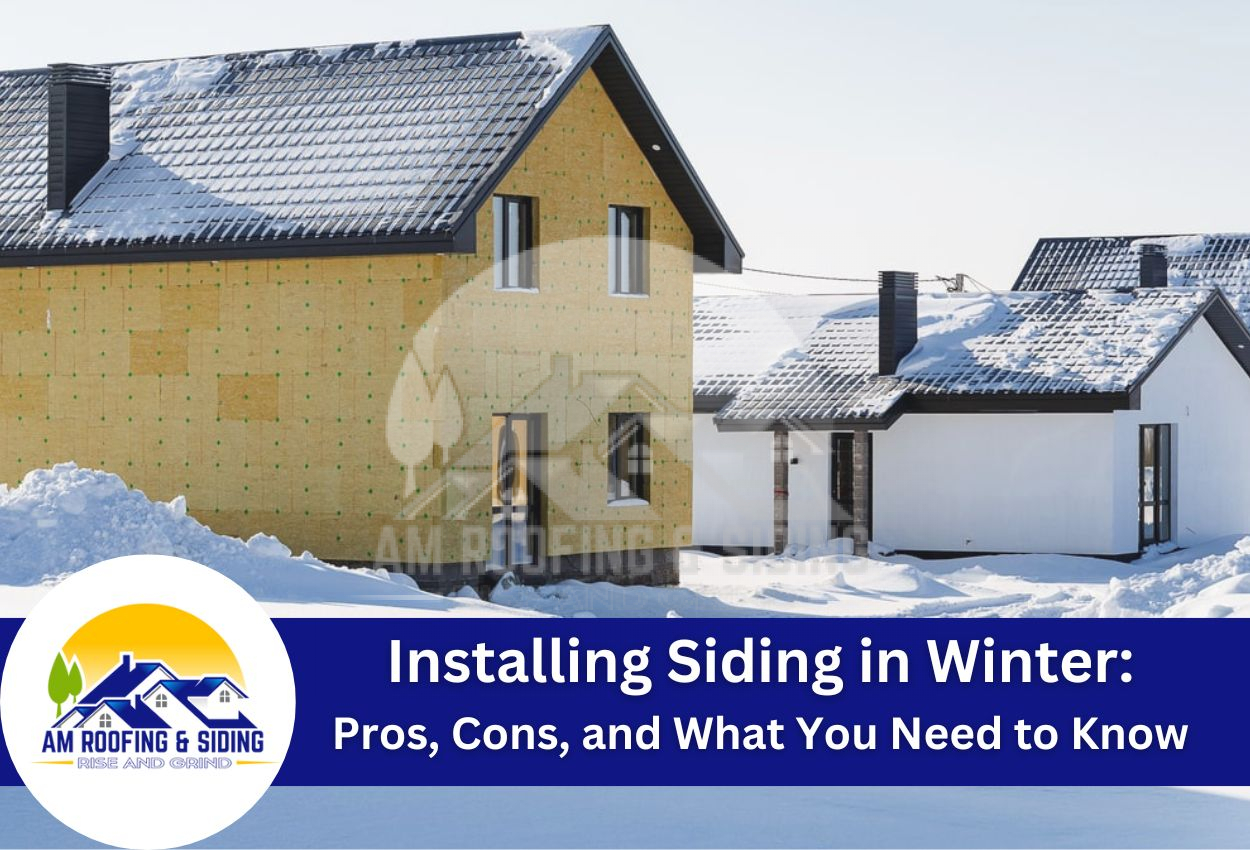When the temperatures drop, many homeowners question whether it’s possible or even a good idea to undertake home improvement projects like installing new vinyl siding. While winter poses challenges for this type of project, understanding them can help you make informed decisions. Installing vinyl siding during the colder months isn’t only possible, it can come with distinct advantages, provided you know how to navigate the hurdles specific to the season.
Unlike the more moderate seasons, winter needs special considerations for installation techniques and materials. Vinyl siding, popular for its durability and low maintenance, behaves differently in cold weather. It becomes less flexible and more brittle in freezing temperatures, which can affect the installation process. However, with the right preparation and techniques, these issues can be effectively managed. In our guide, we will provide essential tips and considerations for homeowners in Central Ohio looking to install vinyl siding in the winter. We’ll discuss the benefits, potential drawbacks, and tips for successful installation during cold weather. Whether you’re wondering about the best siding for cold climates or specific winter conditions that prevent siding installation, this guide will provide the answers you need.
Benefits of Installing Vinyl Siding in the Winter
One of the lesser-known advantages of installing vinyl siding during the winter is the potential for cost savings and easier scheduling. Due to lower demand, contractors in Central Ohio often have more availability in the colder months, which can translate to quicker project start times and potentially lower installation costs. Homeowners considering vinyl siding should capitalize on this opportunity to schedule their projects when contractors are less busy.
Vinyl siding is well-suited for the harsh winter conditions typical of cold climates. Its durability makes it an excellent choice for withstanding snow, ice, and cold winds. Additionally, modern vinyl siding offers improved energy efficiency, which can help keep your home warm during the winter months without overburdening your heating system. By sealing drafts and improving insulation, properly installed vinyl siding can significantly reduce energy bills.
Understanding these benefits can help homeowners decide when to schedule their siding installation. Installing vinyl siding in the winter not only means easier contractor scheduling but also improves the comfort and efficiency of your home during the coldest season.
Concerns About Winter Siding Installation
Installing vinyl siding in the winter in Ohio presents several challenges that homeowners should be aware of. The cold weather significantly affects the material properties of vinyl, making it less flexible and more prone to cracking. Special techniques and tools are required to handle the siding carefully so it does not break during installation. Additionally, the curing times for adhesives and sealants increase in colder temperatures, which can extend the overall timeline of the project.
Homeowners should expect some delays and potential scheduling conflicts due to winter conditions. Inclement weather like snowstorms can pause the installation process, as clear days are required for safe and effective work. Monitoring weather forecasts and planning for clear, relatively warmer days can make a big difference in the installation process. It’s also important to remember that daylight hours are shorter during the winter months, which may limit the working hours available for contractors. These factors necessitate clear planning and flexibility from both homeowners and installation teams.
Despite these challenges, with proper planning and the right contractor, vinyl siding can be successfully installed during the winter. Knowing what to expect and preparing for the specific demands of winter installation means the project is completed without compromising on quality.
Preparing for Winter Siding Installation
Installing vinyl siding in winter requires careful preparation so the project runs smoothly despite the cold conditions. Homeowners and contractors need to gather specific tools and materials that are suited for lower temperatures. For instance, using a cold-weather-rated sealant is crucial because standard sealants may not cure properly in cold weather. Additionally, it is recommended to keep vinyl siding panels in a warm area before installation to prevent them from becoming too brittle.
Preparing the workspace is equally important. Clearing snow and ice from the work area and making sure that it is safe and accessible can prevent delays and accidents. It is also wise to set up a heated workshop or a sheltered area to cut and prepare materials. This not only makes the work more comfortable but also protects the materials from the extreme cold. Special attention should also be given to the house itself, ensuring that old siding is removed carefully and any exposed areas are quickly covered to avoid heat loss.
With these steps, homeowners in Central Ohio can successfully manage vinyl siding installation during the winter. These preparations help minimize the challenges posed by cold weather and ensure that the installation process is not only possible but also efficient and effective.
Types of Vinyl Siding for Your Ohio Home
When choosing vinyl siding for your Central Ohio home, you have several options, each with different benefits and styles. Here are some of the most popular types:
- Traditional Lap Siding: This is the most common type of vinyl siding, featuring long, horizontal planks that slightly overlap. It provides a classic, timeless look that suits most home styles. Its design helps shed water effectively, making it a durable choice for Ohio’s wet and snowy winters.
- Dutch Lap Siding: Similar to traditional lap siding, Dutch lap has a distinctive beveled edge that creates more shadow and depth. This style adds visual interest and a slightly more upscale appearance. It’s a great option for homeowners looking to boost curb appeal while enjoying the low maintenance of vinyl.
- Board and Batten Siding: Also known as vertical siding, board and batten panels create a rustic or farmhouse-inspired look. This style can help your home stand out while providing excellent weather resistance. Since snow and rain slide off vertical panels easily, this siding is a practical choice for Ohio homes.
- Shake and Shingle Siding: Designed to mimic the look of cedar shakes, this type of vinyl siding adds texture and character to your home’s exterior. Unlike real wood, vinyl shakes don’t require staining or sealing and won’t rot, making them a long-lasting and low-maintenance option for Central Ohio’s climate.
- Insulated Vinyl Siding: This type features a layer of foam insulation attached to the back of each panel, improving energy efficiency. It helps regulate indoor temperatures by reducing heat loss, which is especially beneficial during Ohio’s cold winters. Additionally, the added insulation makes the siding more impact-resistant.
No matter which style you choose, vinyl siding is an affordable, durable, and low-maintenance option—perfect for handling Central Ohio’s unpredictable winter weather.
When to Replace vs. Repair Vinyl Siding
Knowing when to repair or replace your vinyl siding can save you money and protect your home from major, and expensive, damage. In Central Ohio, where winter temperatures drop below freezing, siding issues can lead to heat loss and higher energy bills. Taking care of problems early with either repairs or a complete replacement is key to maintaining your home’s efficiency and curb appeal.
When to Repair Your Siding
- Minor Cracks or Holes – Small cracks from impact or weather can often be patched or sealed without replacing the entire panel.
- Loose or Warped Panels – If a few panels have come loose due to strong winds, they can often be reattached without a full replacement.
- Faded or Dull Color – If your siding looks faded but is still in good shape, professional cleaning or painting, depending on the type of vinyl, can refresh its look.
- Mold or Mildew Growth – If caught early, mold and mildew can usually be cleaned off. However, if they persist, moisture could be trapped underneath, indicating the need for replacement.
When to Replace Your Siding
- Widespread Cracks or Holes – If multiple panels are damaged, replacement is the better long-term solution.
- Visible Warping or Buckling – Warped siding can indicate underlying moisture damage, which can lead to rot and structural issues.
- High Energy Bills – If you notice a sudden increase in heating costs, damaged siding may be allowing warm air to escape.
- Water Damage Inside the Home – Peeling paint, water stains, or mold growth on interior walls can indicate that your siding is no longer protecting your home from moisture.
Replacing siding at the first sign of serious damage can prevent heat loss, lower utility bills, and protect your home from future issues. Since installing vinyl siding in winter is a good option for most projects, there’s no need to delay if your home needs an upgrade.
Choosing the Right Siding Contractor for Winter Vinyl Siding Installation
Choosing the right siding contractor is just as important as selecting the right siding for your Central Ohio home. A trustworthy contractor guarantees a smooth installation and protects your home from winter weather. To find a reliable professional, start by looking for a contractor who is fully licensed and insured. These credentials mean they meet Ohio’s building codes and that you’re protected in case of accidents or property damage during the project. Experience also matters, especially with winter installations, since cold weather can make vinyl brittle and affect sealing.
Reading online reviews and asking for references from past customers can help you gauge a contractor’s reputation. A reliable professional will also offer a detailed written estimate that clearly outlines material costs, labor, and potential additional expenses so there are hidden fees. Additionally, look for a contractor who offers a workmanship warranty in addition to the manufacturer’s siding warranty, which means both quality installation and long-term protection.
However, not all contractors are trustworthy, and there are red flags to watch for. Be cautious of estimates that are significantly lower than others, as this could indicate the use of low-quality materials or shortcuts in labor. Avoid contractors who can’t provide proof of licensing and insurance, as this puts you at risk for liability. High-pressure sales tactics, such as pushing you to sign a contract immediately, are also a warning sign. Another red flag is a contractor without a physical business address or local presence, as they may not be available for follow-up service.
Taking the time to research and choose the right contractor ensures a smooth siding installation, even in winter, and protects your home for years to come.
AM Roofing & Siding: Your Winter Vinyl Siding Experts
Ready to transform your home with durable vinyl siding this winter? Don’t let the season hold you back! Trust AM Roofing & Siding to expertly install your new siding, even in cold weather. Enhance your home’s energy efficiency and protection with our professional installation services. Call us today at (740) 974-8268 to schedule a consultation and take the first step towards a cozy, weather-resistant home this winter.

